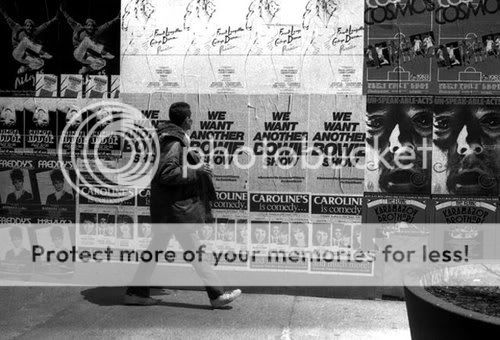Archive for January 13, 2009
Carnival of souls
January 13, 2009* Over at the Cool Kids Table, Ben Morse has posted a series of “collect this heretofore uncollected run of comics puh-leeze!” wishlists from himself, Kiel Phegley, Rickey Purdin, TJ Dietsch, David Paggi, and one Sean T. Collins. Check it out and bug the relevant publishers.
* Get those shopping lists fired up: Douglas Wolk has put together a pretty great list of the major alt/lit/art comics releases coming out in 2009.
* Chris Mautner continues his own series of such roundups, this one focusing on my webcomics publisher, Top Shelf.
* Mautner also weighs in on the big discussion we had here the other week about how to read and review event comics.
* Tom Spurgeon lists 25 great things about being a comics reader.
* Josiah Leighton reprints and examines Katsuhiro Otomo’s pre-Akira short story “Nothing Will Be as It Was.”
* Tim O’Shea talks to Josh Cotter about Skyscrapers of the Midwest, one of my favorite comics of the year.
* Okay, fine, everyone’s got me intrigued about The Winter Men now.
* Stacie Ponder reviews Planet Terror and Death Proof, or as they were once collectively known, Grindhouse.
* B-Sol at the Vault of Horror lists the top 10 scariest paintings of all time.
* Dave Kiersh has posted a preview of his upcoming teen-drama comic, Dirtbags, Mallchicks and Motorbikes. (Via Heidi MacDonald.)
* Finally, remember when I said that I thought Watchmen was going to be a real eye-opener for mainstream audiences in terms of a type of superhero imagery they’d be seeing for the first time ever? Apparently Warner Bros. agrees, because they’re using that as the selling point for the commercial they’ve been running during NFL games and 24. (Via Topless Robot.)
George Duke – Reach for It
January 13, 2009What, are you dense? Are you retarded or something? Where the hell do you think I am? I’m at the goddamn movies.
January 12, 2009Tonight I tried and failed to see Frank Miller’s The Spirit at one of the five total daily showings spread across the three remaining theaters still showing the movie on Long Island–failed because the picture quality was so bad that I got up, got a refund, and left.
When the trailers were shown in seemingly the wrong aspect ratio, I thought “uh-oh,” so I ran downstairs and asked the guy at the concession stand to let someone know to fix it. Then the movie started and while the picture didn’t look so badly accordionned inward anymore, it was still ran waaaaay past the top and bottom borders of the screen–credits disappeared right along with the top third of characters’ heads. The picture was also crooked, which I was subsequently informed was due to the angle of the screen, meaning all the movies they charge people to watch in that particular theater are at least that screwed up. To top it all off, what you could see of the picture was murky, and the surround sound wasn’t working to boot.
I know I was a film studies major, but this was in the era of VHS, so I feel like I’m not hugely particular when it comes to things like picture quality. I still don’t have a hi-def TV or a Blu-Ray player, for example. But I also feel like maybe every third time I go to the movies there’s an enjoyment-destroying, super-obvious problem with something. This time it was the picture being all screwed up. When I saw Doomsday it was the sound not being fully switched on. When I saw Let the Right One In it was the theater being north of 80 degrees. And I’m not even getting into the behavior of my fellow moviegoers. It’s to the point where each time I go to the movies, one of my favorite goddamn activities in the goddamn world, I sit down dreading whatever the hell will ruin it this time.
This is the kind of stupid extrapolation from personal anecdotal evidence that makes blogs so, so awful, but I can’t help it: Surely this sort of thing can’t be good for business? I mean, especially in this case, where the movie theater knowingly has a screen set up so that every single thing they show on it will be tilted to one side like you’re in the hideout of Frank Gorshin’s Riddler. That’s some chutzpah, my friends.
Anyway, I’m really angry that I didn’t get to see The Spirit, because I can’t possibly have a lot of time left to catch it in the theater. The end.
STC/BKV/TCJ again
January 12, 2009The Comics Journal has posted a preview of my cover-story interview with Brian K. Vaughan from issue #295, which hits stores on Wednesday soon and is already available via the Fantagraphics web store. Click the link and thrill to my scintillating questions in all their conversational, barely comprehensible, transcribed-verbatim glory–not to mention BKV’s thoughts on translating his comics into screenplays, working with franchise characters, union vs. non-union writing gigs, and more.
Comics Time: Skyscrapers of the Midwest
January 12, 2009Skyscrapers of the Midwest
Joshua W. Cotter, writer/artist
AdHouse Books, June 2008
282 pages, hardcover
$19.95
The collected Skyscrapers of the Midwest is more than the sum of its parts–and that, friends and neighbors, is really, really saying something. All four of Skyscrapers‘ original issues were dynamite: The first felt like a revival of the old-school one-man anthology altcomix, the second revealed it to be the seeds of a larger story that developed through the remaining three issues, each of which held together as a discrete storytelling unit (gilded with entertaining ACME-style ephemera) but adding depth, breadth, and power to the overall novel. The second issue was, in fact, virtually the perfect comic book. That it sits comfortably between the covers of a larger graphic novel without overwhelming it–that it in fact is enhanced by its new surroundings–is more of a testimonial to Josh Cotter’s work here than I could ever offer.
It’s not just that Cotter’s art take funny-animal-era Crumb crosshatching and doughy character designs; it’s that he applies them to Ware-informed layouts and and subject matter, with the occasional Kupperman-level black-humor interlude thrown in. It’s not just that Cotter matter-of-factly introduces and kills with a seemingly neverending series of crackerjack visual symbols–migraine locusts, cancer squids, God robots, death jetpacks, angel kittens; it’s that sweeping silent sequences where he really lets loose with this stuff segue seamlessly into painfully accurate, rigorously observed recreations of awkward childhood conversations at home, at school, in church. It’s not just that it’s an autobiography that never comes out and says so and is all the more effective for it; it’s that it’s also an equally sensitive and unsentimental portrait of other people in town whose inner lives Cotter couldn’t possibly have access to. It’s not just that it joyously recreates the way pop fantasy figures like He-Man and Marvel superheroes gave kids an outlet for their imaginations above and beyond whatever frequently dreary, yet often wondrous material was actually there; it’s that it also viciously lampoons the material for its benighted assumptions about everything from women to justice, and for the way it literally preyed upon the insecurities of children to make money. It’s not just that it unflinchingly depicts the go-nowhere futility of cancer-ridden, unexamined lower-middle-class life; it’s that it’s also a totally moving tribute to how the relationships we form with one another are the things that last and give us meaning in the face of man’s cruelty to man, man’s cruelty to nature, and God’s cruelty to everything. Skyscrapers of the Midwest, in other words, is simultaneously one of the warmest and the coldest comics ever. It’s brilliant and devastating, and I love it.
A great way to spend your Sunday afternoon
January 11, 2009Rereading all 100 Horror Roundtables at Steven Wintle’s late, lamented The Horror Blog.
Carnival of souls
January 10, 2009* My favorite mafia story, because it’s the story that does the best job of stripping away the Godfather romanticism and revealing mobsters for the shitty little monsters that they are, is the one about how when one of John Gotti’s civilian neighbor John Favara accidentally struck and killed Gotti’s son Frank his car while Frank was riding his bike, Favara was later forced into a mysterious van and was never seen or heard from again. The case is back in the news as prosecutors allege a Gambino soldier dissolved Favara’s body in acid.
* Hey, look, it’s a trailer for George A. Romero’s next zombie movie, which either is or isn’t called Of the Dead. It’s, uh, yeah.
(Via STYD.)
* Jon Hastings ponders film adaptations’ fidelity to their source material, and why it really doesn’t matter. I think Tom Spurgeon had the best take on fanboy complaints about this subject:
what geek culture really means 99 percent of the time [when demanding films be “faithful to the source material”] is “please don’t put us in a position to be mocked or laughed at.”
I think Jon would agree.
* This made me laugh: Harvey Weinstein apparently knows less about the status of Sin City 2 than your average nerdblogger–he literally had no idea Frank Miller had even been thinking of writing the sequel–whereas actress Jaime King says her boy Frank has finished the script for the thing.
Shake Hands with Danger (Remix)
January 9, 2009Carnival of souls
January 9, 2009* Longtime altcomix figure Bill Kartalopolous returns to blogging with a vengeance, posting three worthwhile stories, noting that Pantheon Publisher Janice Goldklang has been let go–in many ways Pantheon may be the most important comics publisher of the decade, so this strikes me as a major development–and flagging release dates for two massive projects from major creators, David Mazzuchelli’s Asterios Polyp (344 pages, June 2, 2009) and R. Crumb’s The Book of Genesis According to R. Crumb (204 pages, Fall 2009).
* Will Fox and Warner Bros. settle the Watchmen lawsuit? Maybe, probably, I guess.
* Marc-Oliver Frisch weighs in on that big event-comics discussion from a few days ago.
* I’d like to be watching the complete original 1967-1968 series of The Prisoner online for free like everyone else, but the stupid Flash video is too hiccuppy on my computer.
* As far as reviews of movies I still haven’t seen go, Jeff Lester’s Oedipal take on The Spirit entertained me.
* I love the idea of Frank Santoro and Gary Panter rocking out to “Sweet Leaf.”
Comics Time: Nocturnal Conspiracies
January 9, 2009Nocturnal Conspiracies
David B., writer/artist
NBM, December 2008
124 pages
$14.95
However their images may resonate with the Jungian collective unconscious, dream comics really do exceed even autobio as sequential art’s most solipsistic genre, a relentlessly inward-looking cataloguing of the contents of the artist’s own head. They’re personal. So I don’t mind filtering this review of a collection of dream comics by the great French cartoonist David B. through my own, equally personal primary reaction to it: They remind me of my own dreams! Like B., I frequently return to action-adventure-thriller scenarios in my dreams, violent vignettes involving skulking, spying, fleeing, and above all the imperative to kill or be killed. Given B.’s background, his antagonists are frequently figures from France’s World War II experience, or terrorists; given mine, my enemies were usually figures from popular culture–zombies, Aliens, mafiosi (terrorists were late entrants). It was enormously comforting for me to discover another mind so consumed with murder and mayhem even when asleep.
The greatest pure stylist of any of the big European cartoonists whose work gets translated these days, B.’s genius lies in how his comics do the same thing that dreams do: Break down full-fledged ideas into simpler, more symbolic totems that remain recognizably of a piece with some waking concern or other but gain power through their abstraction and fluidity. His angular, expressionist style is complemented with both an equally proficient use of curves and an equally stark and judicious deployment of thick blacks and midnight blues–it’s really perfect for evoking the half-remembered mystery and chaos of dreams, even though in actuality those dreams are at the time as realistic-looking as our waking lives. Though the comparatively rigid layouts and the placement of narrative captions at the top of most panels leads to an unpleasantly staccato feel at first, eventually you get used to it–or B. does, I’m not quite sure which; at any rate he occasionally abandons the captions altogether, usually to enhance the shock and the you-are-there feel of what he’s presenting. Beyond the engrossing dreams themselves, Nocturnal Conspiracies of course serves as a showcase for the many, many things David B. draws as well as anyone in the business, from warriors and weapons to hair and breasts; there’s a panel in here that’s the loveliest depiction of sexual penetration I’ve ever seen in a comic. Though less ambitious both narratively and visually than Epileptic, Babel, or the fable comics he’s done in MOME, this is delightful work.
Carnival of souls
January 8, 2009* The New York Comic Con panel schedule is up, mostly. (“Most” movie and TV panel information TK, annoyingly.) If you’re interested in seeing Sean T. Collins in his first comic convention panel ever, you’re welcome to come to the Twisted ToyFare Theatre panel on Saturday 2/7 at 5:30pm in room 1A17.
* U.S. District Judge Gary A. Feess will decide whether WB can release Watchmen on Inauguration Day, January 20th. Yes we can.
* Missed it: Quentin Tarantino’s World War II action flick Inglorious Basterds comes out on August 21st of this very year.
* Mickey Rourke and Sam Rockwell are going to be bad guys in Iron Man 2. Sounds good. Still no Mandarin, I guess.
* I get a kick out of how into year-end best-of list-making Dick Hyacinth gets. I’d guess I’ll have my own list ready in a couple weeks.
* Graeme McMillan on Dark Reign:
In a weird way, I can’t help but feel as if Dark Reign is really, really shittily timed. Dark Avengers, the core book for the branding, gets released the day after Obama gets sworn in as President of the United States, and it’s that cognitive dissonance that sticks in my mind. Marvel, for all their faults, are normally more in tune with the cultural zeitgeist than Dark Reign; it feels oddly… wrong, and somewhat DC-ish, to see them plunge into a depressing world of misuse of power at a time when we’re about to bring in a President who made the country believe in Hope and Change again. Maybe they know something we don’t… or maybe this is a sign that they’ve lost their touch.
This really is a problem. It’s not even a political issue, really–it’s that the guy has like an 80% approval rating, meaning that people in this country would have a hard time swallowing the idea that he’d put a mass murderer in charge of the American security apparatus. Seriously, Marvel Barack Obama just named the Green Goblin head of the equivalent of the CIA; Real World Barack Obama just named Leon Panetta. It’s really rather tone-deaf. This kind of thing doesn’t cut it, either.
* Kyle Baker makes the point I’ve tried to make, which is that there’s plenty of the stuff you’ll find in Frank Miller’s Spirit in Will Eisner’s Spirit, along with a lot of other things. Still haven’t seen the damn movie, though. (Via Heidi MacDonald.)
* Battle-damaged He-Man T-shirts? That’s pretty rad.
* Finally, who doesn’t?
Comics Time: Invincible Iron Man #8
January 7, 2009Invincible Iron Man #8
Matt Fraction, writer
Salvador Larroca, artist
Marvel, December 2008
32 pages
$2.99
Here’s a good example of how event comics can hijack a perfectly good ongoing series. Matt Fraction’s take on Iron Man fortuitously jibes so neatly with Jon Favreau and Robert Downey Jr.’s that its opening arc read like an adaptation of a nonexistent movie sequel. It featured Iron Man/Tony Stark on top of the world but cognizant of his limitations and the danger of his war machines. Now, however, the events of Secret Invasion mandate that Stark be removed from his perch atop the S.H.I.E.L.D. defense/espionage agency, to be replaced by the publicly rehabilitated captain of industry and serial killer Norman “The Green Goblin” Osborn–instantly, Fraction must throw the character’s previous mien and milieu out the window. Indeed, everything that happens in the comic reminds us of the noxious ideas from other comics upon which they are contingent. For example, the presence of Osborn as Stark’s successor is due to a ludacris plot twist from Secret Invasion, best analogized by Newsarama commenter Old Doom as “…O J Simpson cuts off the head of Osama Bin Laden on tv, and they make him the head of the C I A.” Osborn and Stark tussle over the Superhero Registration Database, which owes its existence to a Civil War character turn in which Iron Man put his fellow heroes in black-site prisons, in service of implementing a superhero training and licensing program that would be perfectly reasonable if not for the event’s writers inability to grasp the basic contours of their central metaphor. Fraction does his best with what he’s been given, and his best is quite good. And as long as you can block out why everything that’s happening is happening, it’s fun to watch the superhero outthink the supervillain while surrounded by female characters who look like the movie stars they were photoreffed from. But it’s hard to stay invested in a character who works best as a confident, competent, self-aware genius when everything about his current situation is derived from him being a brutal, bumbling, oblivious asshole in other people’s comics.
When I say, when I say come on Ron, I say, I say come on Ron, I say come on Ron, now lemme, I say come on Ron, lemme hear ya tell em, lemme hear ya tell em how I, tell em how I, tell em how I, tell em how I, tell em how I, tell em how I feel.
January 6, 2009I say, I say c’mon lemme hear you tell em, tell em how I feel. Yeah. Yeah. Yeah. Huh.
Carnival of souls
January 5, 2009* My latest piece on Marvel’s adaptation of Stephen King’s The Stand is up at Marvel.com–this one’s an interview with writer Robert Aguirre-Sacasa focusing on a look back at the project so far and where it’s headed next.
* There’s lots of good stuff in Tom Spurgeon’s interview with Matt Fraction–the final installment in his Holiday Interview series–but this is probably the juiciest bit:
SPURGEON: One of the more interesting about the art in your Iron Man is Salvador Larocca’s visual references to celebrities–in fact, you’ve worked with a number of strong stylists. Is there any way that you as a writer will respond to or make choices based on stylistic strategies undertaken by an artist with whom you’re working?
FRACTION: I can’t stand that stuff, personally — yanks me out of the story immediately. Not photo referencing, that’s not what bugs me, but using celebrities just… it’s as intrusive as someone standing over your shoulder reading the word balloons with funny voices. Bums me out.
Wow, on the record and everything. But it really does interfere with my enjoyment of the series, which is otherwise quite good. Hmm, Fraction must also love working with Greg Land on Uncanny X-Men, huh?
* Speaking of Spurge, here he reviews early Daredevil and notes how the creators’ uncertainty of what the point of the book was supposed to be gave them a lot of freedom. The funny thing about Daredevil as a character is that most of the great work done with the character, and there’s been a disproportionate amount of that, has been tonally consistent from one creative team to another, so it’s a momentary surprise to recall that it wasn’t always noir and ninjas.
* Don’t know why I’m just getting to this now, but the original Blog@Newsarama crew is back and blogging at Comic Book Resources under the moniker Robot 6. Welcome back!
* And on that note, here’s Robot 6’s Chris Mautner running down Fantagraphics’s Spring/Summer 2009 publishing plans.
* WoW Among the Ruins: Bruce Baugh takes a look at a less-traveled area of World of Warcraft, one that had once been the site of a lot of action, and notes its post-catastrophic ambiance.
* Jog reviews the first issue of Ed Brubaker and Sean Phillips’s supervillain noir Incognito, echoing my sentiments about the comic in two particulars: 1) It feels a bit shopworn, at least at the moment; 2) It’s like Brubaker wanted to see what Wanted would be like if it were written by a good writer.
* Finally, a welcome Real Life Torture Porn update:
We cannot and we must not use torture under any circumstances. We are better than that.
Welcome back!
January 5, 2009Greetings to all whose Internet usage declined somewhat during the holiday break. Here are some reviews I posted during that time that you may have missed.
* Breakdowns: Portrait of the Artist as a Young %@&*! by Art Spiegelman
* The Best of the Spirit by Will Eisner
* ACME Novelty Library #19 by Chris Ware
* Twilight directed by Catherine Hardwicke
* Let the Right One In directed by Tomas Alfredson
* ‘Salem’s Lot by Stephen King
* a discussion of event comics crticism centered on Grant Morrison’s Final Crisis and Batman: R.I.P.–check out the comment thread for thoughts from Tom Spurgeon, Tucker Stone, Tim O’Neil, Matthew Perpetua, Marc-Oliver Frisch, Bruce Baugh, Jon Hastings, Kiel Phegley, Ben Morse, Shaggy Erwin, Sean B. and more, I think
The posting of that Spirit review marked the successful completion of one full year of Comics Time comic book reviews going up on this blog every Monday, Wednesday, and Friday, without fail. I’m proud to have done what I set out to do a year ago. I had a lot of fun reading that many comics, and perhaps to my surprise I had a lot of fun writing about that many comics, too. I’m certainly a better comics writer than I was when I started, and I think the blog is better overall. For this I’d like to thank all my readers, particularly those who emailed or posted comments. I’d also like to thank all the publishers who generously donated review copies.
In the New Year I don’t think I’ll be reviewing comics with this same level of regularity. Prose books beckon, as do sizable runs of comics that are hard to fit into your schedule when you’ve got to have three reviews up a week. That said, you’ll see some backlog reviews popping up in the regular slots for a little while, and chances are good that if I read a substantial comic, it’s gonna get reviewed here on the blog. (The occasional insubstantial comic will be thrown in for good measure.) I’m going to work my way through the remaining 2008 notables in time to put up a semi-timely Best of 2008 list of some kind as well. But for now, a leisurely re-read of Ed Brubaker’s Captain America run beckons…
Comics Time: The Immortal Iron Fist #21
January 5, 2009The Immortal Iron Fist #21
Duane Sweirczynski, writer
Timothy Green, artist
Marvel, December 2008
32 pages
$2.99
The Immortal Iron Fist as co-written by Ed Brubaker and Matt Fraction and drawn by an ace team of artists led by David Aja was the most acclaimed Marvel comic to come along in quite a while. It took a largely forgotten character, reimagined and expanded his mythos, carved itself a storytelling space far outside Marvel’s current military-industrial superhero idiom, incorporated video game and manga influences, looked lovely, and was both thrilling and funny, which is hard to pull off in superhero comics. (Usually they’re one or the other.)
But Brubaker, Fraction, and Aja left the title rather quickly, and pulp writer Duane Swierirczynski took over. I liked his opening storyline well enough. The antagonist, a mystical Iron Fist terminator of sorts, fit right into the kinds of things Frubaker were doing with villains and the Iron Fist legacy, and the tone was right as well. I might have tried to do more with all the other Immortal Weapons that had just been introduced–witness how well Brubaker juggles supporting super-characters in Captain America and Daredevil, for example–but hey, it’s his first shot. The much bigger problem was with the art, provided by Travel Foreman. With a wiry line that is often drowned out by thick, murky blacks, it bobbled the two balls that absolutely need to be kept in the air for this iteration of this character to work: character design and action choreography.
This stand-alone issue is more like it. Artist Timothy Green shares enough with Foreman that at first I thought that the latter artist had simply varied his style or had a different inker/colorist support team working with him. But Green’s work is both looser (meaning less cramped) and tighter (meaning more self-assured). Yes, the backgrounds often disappear, but that just gives more breathing room for his Seth Fisheresque design flourishes, and for Edward Bola’s pretty pastel colors. With the visual handicap removed, you can now really see that Swierczynski gets this character and this concept. A story that takes place a thousand years into the future, pitting a cyborg Fat Cobra against a nine-year-old Iron Fist who uses his chi to form a giant robot, and features as a key plot point a kung-fu punch that takes over twenty years to deliver? It’s the exact same blend of majesty, absurdity, and creativity that made the earlier IIF so much fun. If the rest of Swierczynski’s run looks like this, sign me up.
Carnival of souls
January 3, 2009* Hooray! My old friend Josiah Leighton–the guy who kept me abreast of comics during my collegiate hiatus from ’em–is back with a bunch of posts about how different artists do what they do. Here he is on Anders Nilsen, Aron Wiesenfeld, and panel borders. Here he is on Wally Wood, Daredevil, and character design, with a bonus origin story for his own life as a comics reader that I think is my favorite such tale I’ve ever heard. And here he is on Erik Larsen and the joys of Savage Dragon.
* Jog presents his Top 20 Comics of 2008. I don’t wanna spoil it for you, but this bit from his write-up of Comic #1 made me laugh:
And I fucking liked the collage! Yeah, that’s goddamned right! In fact, I’m calling it now – 2009 is all collage! Fantagraphics? Collage! PictureBox? Collage! First Second? Children’s publishing collage! Kramers Ergot 8 is a 60-foot collage propped up against the Marriott Bethesda North Hotel & Conference Center! Ultimatum #5 is the Ultimate Collage! The Battle for the Cowl is won by writer/artist Tony Daniel and the fists of collage, via collage! Where’s my paste? My notebook? My pillow?? Where’s the Publish Post button?! I am personally killing 2008 with my two hands, right this second.
* Marc-Oliver Frisch picks the nits out of Marvel and DC’s March solicits.
* Top Shelf co-honcho Brett Warnock takes a gander at Twin Peaks.
* Anders Nilsen draws the devil, and other sketchbook delights.
* Finally, via Sean B.’s sexy new photo tumblog A Stranger’s Candy, David Bowie and Iggy Pop. Toothy!
Carnival of souls
January 2, 2009* Happy New Year, everyone. The Missus and I have kicked off 2009 by being as horribly sick as we’ve ever been. Interestingly, this was also how we kicked off 2000. I don’t know what it is about that damn ball dropping that it always has to land squarely on our immune systems.
* Before my life became a David Cronenberg movie, I wrote some things about event comics that kicked off a lengthy discussion in the comment thread by a galaxy of blogospheric stars, including Tucker Stone, Tim O’Neil, Tom Spurgeon, Marc-Oliver Frisch, Sean B., Matthew Perpetua, Ben Morse, Shaggy Erwin, Jon Hastings, Kiel Phegley, and Bruce Baugh. It was still going as of this morning, so pop in and see what you think. O’Neil and Dick Hyacinth have related thoughts at their own blogs.
* If you’re like me and you think Abhay Khosla’s be-boppin’ and scattin’ impedes rather than enhances his criticism, you’ll really appreciate Tom Spurgeon’s holiday interview with him–once you get past the opening answer, the schtick largely evaporates and leaves behind insightful commentary about a wide variety of comics. I particularly liked what he said about whether superhero fans “deserve” being taken advantage of. And even when he’s saying things I disagree with, like praising Civil War for being a bona fide “universe breaker” event comic–which is true, but it broke it in bad ways–he’s still on to something.
* Speaking of Tom (and over the holidays, when aren’t we? dude keeps the comics blogosphere alive singlehandedly between Christmas and New Year’s), here’s some shelf porn strait outta the Spurgecave.
* The gross thing about both Fox’s attempted derailment of Warner Bros.’ Watchmen movie and Tribune’s apparent scuttling of Drawn & Quarterly’s Walt & Skeezix collection of old Gasoline Alley strips (the original post is MIA) is how transparently little either has to do with what benefits the work, the audience, or the original creators.
* Jon Hastings, action-movie philosopher, tackles The Spirit.
* Tentacle update part one: More sessy drawings of girls, hair, and suction cups from Becky Cloonan.
* Tentacle update part two: Monster Brains presents a gallery of preserved cephalopods.
* Finally, get it before Lionsgate yanks it: the trailer for Crank 2: High Voltage. This is a real movie.
Comics Time: ACME Novelty Library #19
January 2, 2009ACME Novelty Library #19
Chris Ware, writer/artist
The ACME Novelty Library/Drawn & Quarterly, October 2008
80 pages, hardcover
$15.95
My ability to track who visits this blog for what reasons is beyond rudimentary, but I know that there are horror fans who aren’t interested in the comics material, and comics fans who aren’t interested in the horror material, and general genre fiction fans who aren’t particularly interested in either, and so on. I’d like you all to stay tuned because this book concerns all of you. But first let me throw the superhero fans a bone by talking about Nightwing for a second.
A while ago there was a storyline in one of the Bat-books where the ex-Robin named Jason Todd (he had been dead, but he got better) spent a year pretending to be Nightwing, the current crimefighting alter ego of fellow ex-Robin Dick Grayson, and no one knew the difference. In real life this would be totally ridiculous, because a domino mask isn’t enough to prevent you from telling the difference between two different people. But in comics, you can’t hear people’s voices, and character likenesses from artist to artist, and sometimes even panel to panel, are so inconsistent that any two characters with the same basic skin tone and hair color might as well be doppelgangers. In other words, this is a story could only be done in comics is because it takes advantage of comics’ unique weaknesses.
The reason Chris Ware’s stories can only be done in comics, the reason Chris Ware is the best cartoonist in the world, is because he takes advantage of comics’ unique strengths. His is the most naturally comics way of seeing the world I’ve ever come across. For example: With a few meticulous lines he reduces the descent of a rocket through the Martian atmosphere to a silver circle, a red dot, and an expanding cloud. Through tricks of scale and perspective he then uses that same basic visual vocabulary to depict a ball in mid-flight, a button on an instrument panel, a door, a window, a helmet, a planet, thumbtacks, faucet handles, a tiny illuminated patch in a sea of darkness, a shining flashlight blown up to gargantuan proportions, the entire universe shrunk down and crushed between the silhouetted of two colossal fingers. And far from empty formalism, it’s done in service of a vicious, thrilling science fiction*/horror story about a sociopath–in other words, someone innately incapable of properly ascertaining scale and perspective in his own emotional life and that of those whom he hurts. (Perhaps the ancestor of this story’s omnipresent circle imagery is HAL 9000, then? Certainly the closet comparison I can think of to ACME #19’s horror images–world-class stuff involving freezing, corpses, dismemberment, and isolation–is the cabin-fever coldness of Stanley Kubrick’s 2001 and The Shining, and that’s even before we get to more specific points of similarity.)
In essence, these circular pictograms–and now that I think about it, Ware’s unique, complex, trademark panel layout and sequencing, the very stuff of his comics–have no inherent meaning; we determine their meaning through context and assign it to them. But that means that if we falter or get it wrong or simply say “fuck it,” it’s all quite literally meaningless, as devoid of worth and value as the bogus maps and video communications are to the story’s Martian colonists–or as human life is to murderers, or as existence itself is to those who’ve given up trying to make it mean something.
But there’s more. Ware then applies the same shifting-scale trick he’s done with the visuals to the entire story itself. He pulls back to reveal the story behind the story, that of its in-fiction author. Now we learn the source of this story’s seething rage and deadpan but visceral horror, providing it with context (loved the reveal of why the sci-fi story’s description of its female lead didn’t match her visual depiction) even as it continues to dismantle the semantic underpinnings of the very notion of context. In much the same way that the sci-fi story’s protagonist becomes morally adrift following a dual crisis in confidence over his mission and his fellow missionaries, his author is pushed to the emotional brink by his futile attempts to understand and possess his mercurial “romantic” interest, by his own inability to place his relationship’s true emotional content in the proper scale and perspective. Throughout this meta-narrative he literalizes this failing of vision, both physically (our hero’s glasses are shattered, leaving him looking at the world in part or in full as an assemblage of Benday dots–those circles again) and psychologically (a flashback sequence in which our hero’s life is depicted as leading inexorably toward this ill-fated series of sexual liasons, here viewed as the connection of soul mates).
The business we see in the author’s life is small beer compared to the life and death struggles and cosmic forces at play in that of his fictional protagonist, but that’s exactly what makes it so devastating. If all it takes to untether us so completely from the notion that our lives have and tend toward meaning is a shitty relationship with an emotionally unavailable and damaged person, what hope do any of us have? By the time you reach the alarmingly proficient prose sci-fi pastiche that ends the collection (it’s about time travel’s dissolution of the meaning of time and therefore life), or the uncharacteristically blunt and brutal political swipe on the back cover (it’s about how the causes, goals, means, ends, and legal framework of torture are completely nonsensical), you’ve already gotten the point. Gotten it, in fact, the first time you failed to tell the difference between the surface of a world and the tip of a finger.













